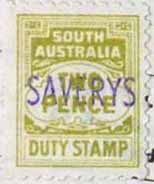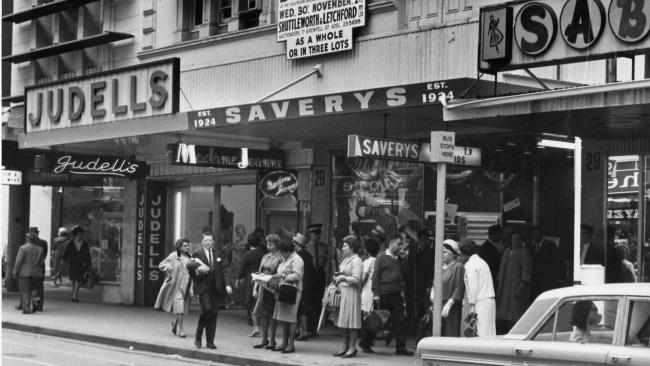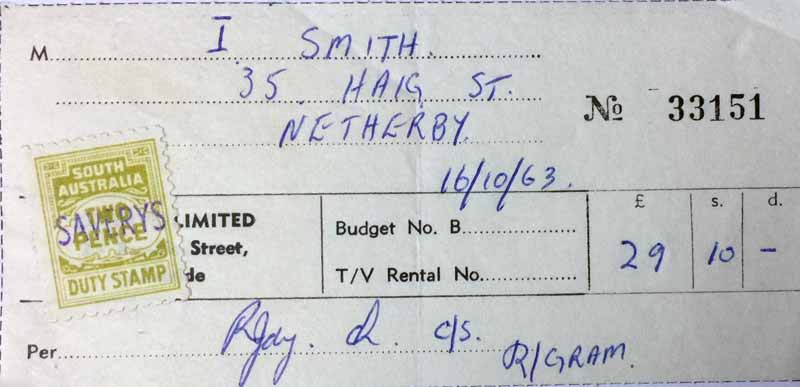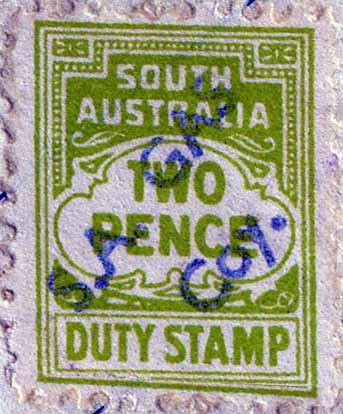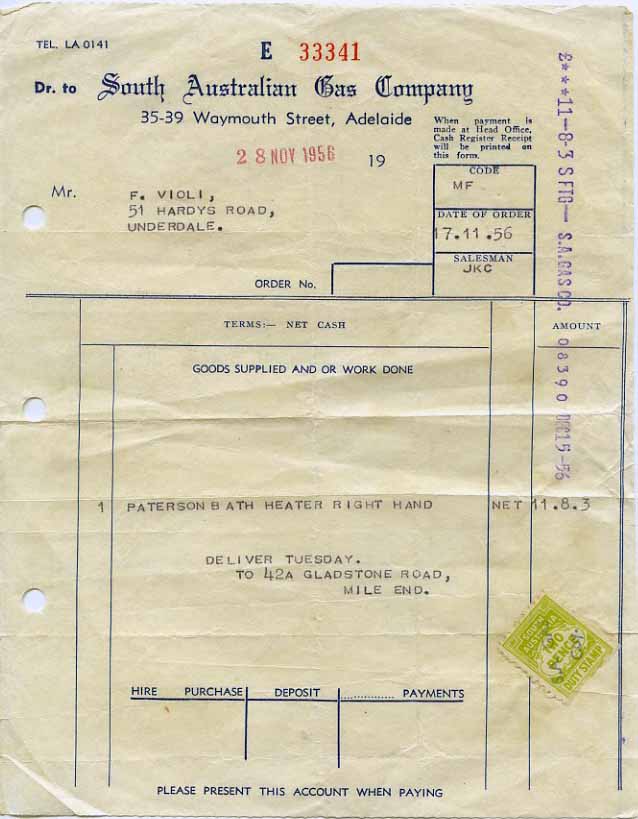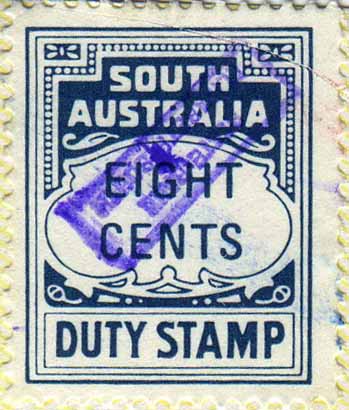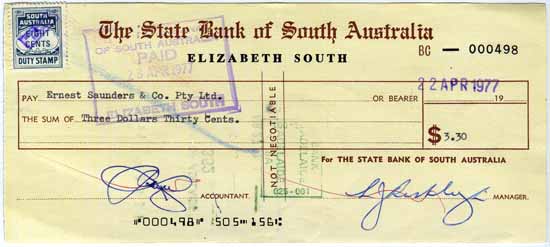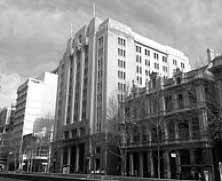|
Private Revenue Perfins of South Australia An Elsmore Coath Howard production The authors would welcome your comments additions or input into this work
Back to SA 'Other' page Back to States Perfin index Back to Commercial Overprint index Section 2 - Commercial Overprints S -------------------------------------------------------- SAVERYS.a
User: Saverys Pty Ltd Rental provider Address: 29 Rundle St, Adelaide, SA. Revenue Use: 1920 Series 2d. Rarity Scale:
1920 Series 2d R4. Background: Savery’s Pianos Ltd opened for business in early September 1922, at 29 Rundle Street (now Rundle Mall)(opposite James Marshall’s). The managing director was S.W. Slavery, who came in 1919 from Sydney, where he controlled the largest piano distributing business in Australia. On arriving in Adelaide he became an active partner in the piano business of John Evans Ltd. An active director in the new company was W.M.R. Manderville who had established Mandeville Supply Stores in Rundle Street from 1904 to 1916 when he joined the Australian Red Cross Society. The company soon diversified into selling phonograms, radios and other entertainment based electrical goods. By 1936, Savery’s Pianos Ltd had become “South Australian distributors of domestic Kelvinators” (refrigerators) and also opened a branch in Port Pirie, initially at 166 Ellen Street, later moving to 9 Alexander Street. By 1950 Savery’s Pianos Ltd was a “piano and electrical distributor” selling sewing machines, food mixers, washing machines amongst other electrical items. In March, 1950, pianos had become a minor department in the business and the company’s name was changed from Savery’s Pianos Ltd to Savery’s Ltd. Subsidiary companies of Radio Wholesalers and Dobbies had been acquired and were housed in the Churchill Buildings, Gawler Place, together with all the company’s service departments. In 1952, Savery’s Ltd. purchased Gambier Radio Service in Mount Gambier from H.L. Green & Son, which continued trading under that name. In October, 1953, David Murray Ltd launched an ultimately hostile take-over bid for Savery’s Ltd. Savery’s countered by raising capital through a new share issue and later a preferential share issue seeing off the raider. By 1954, Savery’s branches were located not only in Port Pirie and Mount Gambier but also Port Adelaide and Broken Hill. In 1969, Slavery’s was now Slavery’s Pty Ltd and still located at 29 Rundle Street (Mall). Device: Handstamped Related patterns: Nil
--------------------------------------------------------
S.A. GAS/Coy..a
User: South Australian Gas Co Gas Provider and Distributor Address: 35-39 Waymouth St, Adelaide, SA. Revenue Use: 1920 Series 2d. 1966 Series 5c. Rarity Scale:
1920 Series 2d R1.
1966 Series 5c R4. Background: *The South Australian Gas Company was formed in May 1863 by an Act of the South Australian Parliament, following 2 years of effort by Government and private interests. The initial gas works were located at Brompton and produced what is known as “town gas” which produced gas from the consumption of coal. Initial support was weak and Adelaide lagged behind the eastern cities in the provision of this utility compared with, for Sydney (1841), Melbourne (1856) and Hobart (1854). The demand for gas grew steadily but in the 1890’s the gas lighting monopoly was threatened when electricity was introduced, however the decrease in the use of gas for lighting was more than offset by the growing demand for gas for cooking and heating appliances. The company remained a producer and a distributor of gas until the 1950’s but with the building of the Oil Refinery at Port Stanvac the company looked to become just a distributor of the Liquefied Petroleum Gas. However in 1966 the Moomba natural gas fields were discovered in north eastern South Australia and in 1969 following the construction of a 790 kilometre pipeline to Adelaide buy Santos Limited, the South Australian Gas Company became committed to the distribution of natural gas. The company became Sagasco in 1978 following a merger between the South Australian Gas Company and the government-owned South Australian Oil and Gas Corporation with former Delhi Petroleum executive Fraser Ainsworth as Managing Director. Ainsworth went on an aggressive acquisition program buying gas reserves across Australia and the company grew steadily. In the early 1990’s the South Australian Government decided to sell its stake in the company and an offer was made by the Adelaide-based oil and gas producer Santos Ltd. However this bid experienced problems in Trade Practices Commission (TPC) because of fears that a Santos - Sagasco combination would dominate the eastern States' gas markets and curtail competition. An offer from Industrial company Boral was accepted and as a result of this acquisition and a similar take over in Brisbane Boral was established as one of the major players in Australia's gas industry. Device: Handstamped Related patterns: Nil *Wikipedia “The Unquenchable Flame – The South Australian Gas Company 1861 – 1986” by Peter Donovan and Noreen Kirkman Boral website
-------------------------------------------------------- SHELL/CO/LTD..a
User: Shell Company Ltd Oil Provider and Distributor Address: Adelaide, SA. Revenue Use: 1920 Series 2d. Rarity Scale:
1920 Series 2d R4. Background: *Royal Dutch Shell, commonly known as Shell, is a global energy company headquartered in the Netherlands and with its registered office in London. It is the second-largest energy company and the fifth-largest company in the world with operations in over 90 countries. Shell Transport and Trading Company was started in the early 1800’s by Marcus Samuel, a London antique dealer who imported seashells from the Far East to supply the fashion and manufacturing industries. This later became a thriving import-export business run by his sons, Marcus (Jr.) and Sam. In the mid 1800’s oil was largely
used in lighting and lubricants but with the arrival
of the internal combustion engine in the 1880’s
there was increased demand for transport fuel.
Building on their shipping expertise, the Samuel
brothers commissioned a fleet of steamers to carry
oil in bulk. This was formalised as the Shell
Transport and Trading Company in 1897and it used a
mussel shell as its logo. Shell Transport’s activities in the
East, combined with a search for new sources of oil
brought them into contact with Royal Dutch
Petroleum. The two companies joined forces in 1903
to protect themselves against the growing power of
the US based Standard Oil. They fully merged into
the Royal Dutch Shell Group in 1907. At this time
Shell changed its logo to the scallop shell, which
is used today. Device: Stencil Related patterns: Refer to other Shell patterns in: NSW: Other - Section 2 Commercial
Overprints: Nil. QLD: Other - Section 2 Commercial Overprints: SHELL.a-.f TAS: Other - Section 2 Commercial
Overprints: SHELL.a SHELL.b VIC: Other - Section 2 Commercial
Overprints: SHELL.a-.d WA: Other - Section 2 Commercial
Overprints: SHELL/CO/LTD.a Refer to other Neptune patterns in: TAS: Other - Section 2 Commercial
Overprints: NEPTUNE.a VIC: Other - Section 2 Commercial
Overprints: NEPTUNE.a NEPTUNE.b *Wikipedia and Shell Australia web
site. -------------------------------------------------------- STATE BANK/ ELIZABETH SOUTH..a
User: The State Bank of South Australia Bank Address: Elizabeth South, SA. Revenue Use: 1966 Series 8c. Rarity Scale:
1966 Series 8c R4.
Background: *The company that would become “The State Bank of South Australia” was formed in the March 11, 1848 as “The Savings Bank of South Australia”. The banks first loan was a historic one, when it advanced 500 pounds to farmer and owner of a fledgling hardware business, John Colton. This business later grew into the well-known Adelaide firm, and perfin user, Colton & Co (later, Colton, Palmer and Preston). In 1875 Colton was appointed to the Bank's board of trustees. By the end of the bank's first year it had attracted 214 depositors, with balances of more than 5,300 pounds and had a loan book of around 3,000 pounds. The Bank grew steadily under the management of some of the icons of Adelaide business and became the largest financial institution in South Australia. In 1984 “The Savings Bank of SA”, merged with “The State Bank of SA” merged with the company taking the name of “The State Bank of SA” and later Bank SA.
Following a funding crisis and State Government bail out in 1992 it was sold to Advance Bank then later this entity was absorbed by the St George Bank and then later St George were acquired by the Westpac Banking Corporation.
At this stage the Bank was relaunched as BankSA and they grew to over 100 branches in South Australia are once again the Northern Territory and are once again the largest financial institution in South Australia.
Former Savings Bank of SA, now BankSA head office, King William St, Adelaide.
Device: Handstamped
Related patterns: Nil *Wikipedia --------------------------------------------------------
Back to SA 'Other' page Back to States Perfin index Back to Commercial Overprint index © copyright 2011 |
